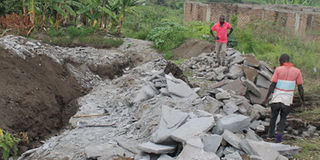Pozzolana mining brings fortune to Kabarole residents

Miners excavate pozzolana stones in Kabalore District. Photo by Alex Ashaba
For over 50 years artisanal miners have been mining pozzolana in Kabarole District. The mineral has provided employment and it is a source of income to hundreds of people.
While deposits are in different parts of the Rwenzori region, most of the deposits are found in Kabarole District.
Pozzolana, an underground mineral is commonly found in the Kichwamba and Harugogo sub counties.
Scientists believe it was formed during the volcanic process and this is the reason, according to them, it is commonly found in Kabarole and Rubirizi districts that are believed to have experienced volcanic activity.
The whitish grey material is derived from one of the primary deposits of volcanic ash.
During extraction, it is broken into small pieces for easy transportation. It is used in the manufacture of cement and house construction.
This mining activity has changed lives of many people. Mr John Mugume, a miner in Harugogo said that from childhood, his parents were involved in the mining activity.
Mr Mugume says he earns about Shs3 million a month, from selling pozzolana and says it is a blessing to the people.
Mr James Alimpa, another miner, says he has been in the business for over 30 years.
“It’s my source of livelihood and I am able to support my family,” he says.
It is estimated that over 1,000 people in the area are involved in pozzolana mining.
How pozzolana is mined
Mr Alimpa says the mineral exists about three metres underground and is easy for miners to extract it since it does not require the use of capital intensive technology like tractors.
Sometimes, the miners dig for about 10 metres deep to extract the rock.
Miners use tools like spades, hoes, and hammers.
The extracted rock is split into pieces before being transported to the factory where it is mixed with other materials to make cement.
How the mineral is sold
Since 1992, Hima Cement Factory has been buying pozzolana from miners in Kabarole District. The factory is the biggest consumer of the mineral and is situated about 60 kilometres from Fort Portal town, in Kasese District, from
A recent Memorandum of Understanding between Pozzolana Miners, Transporters and Drivers Association and Hima Cement Factory in May last year states that each tonne of pozzolana delivered to the factory costs Shs25,000.
According to the MoU, the pozzolana transporters are required to supply 50 per cent needs of pozzolana mineral to Hima Cement Factory.
On average, each day, over 30 trucks ferry the mineral to the Hima Cement Factory.
Other miners sell directly to builders who use the mineral rock to construct houses and drainage channels while others use it as pavers.
In fact, dozens of people in Kabarole District have abandoned the use of bricks and concrete in the construction of houses as they opt for pozzolana which they mix with soil or cement to construct houses.
A big truck that ferries pozzolana to the factory, miners say, goes for between Shs150,000 to Shs200,000 while on the local market, builders buy a small lorry at Shs50,000.

Some residents use it to construct houses and wall fences. Photo by Alex Ashaba
Mr Tadeo Mukonyezi, the manager of Royal Transit Company Limited, says that every quarter, the company pays Shs10 million to each sub county where they extract the mineral, as royalties.
He says they got land leases from individual land owners to extract the mineral.
Development
People living in the area say that the activity has spurred development.
Among the developments include access to road networks, water, electricity and schools.
Access roads that have been improved to ease transportation include Kitarasa- Kichwamba, Kyakagusa-Buharabuzi, Bwanika-Geme and Bwanika-Saka-Katojo roads.
Kabarole District chairman, Mr Richard Rwabuhinga said because of the increased demand for the mineral, there was need to work on roads that connect to mining areas in different sub counties.
The areas have been also connected to electricity and piped water.
Mr Jackson Magezi, the chairperson of Bwanika parish said some investors are rushing to the area to get land for mining
The cost of land has also changed.
An acre of land (not near the road) goes for between Shs18 million to Shs25 million while an acre of land near the road goes for between Shs30 million and Shs40 million.
Twenty years ago, residents say, an acre could go for Shs2 million.
Challenges
As with every other mining activity, challenges exist and pozzolana mining is not exempt. Most of the miners don’t wear protective gears while mining.
Mr James Baguma, a miner, said they want the price of the mineral to be increased because some miners find it challenging to ferry pozzolana to the factory.
He says that the government should consider setting up a cement factory in Kabarole District to create more jobs.
Environmental impact
The mining of pozzolana has also created environmental concerns. The land where pozzolana is mined becomes unproductive after mining activities.
There is loss of vegetation cover in most areas where mining takes place causing soil erosion.
The eroded materials contaminate water points in the area.
The use of excavators to extract pozzolana creates both noise and air pollution.
The Innovation Manager, Hima cement, Mr Philemon Mubiru said pozzolana is a useful material used the manufacture of cement.
He says that the Uganda National Bureau of Standards cement standards has 27 classes of cement and pozzolanic cement is one of them.
“After mining pozzolana it is put in the drier and transferred to the plant where clinker which is made from limestone and gypsum are added to get cement,” he says.
He says cement that has pozzolana reduces the effects of heat which causes cracks in concrete.



